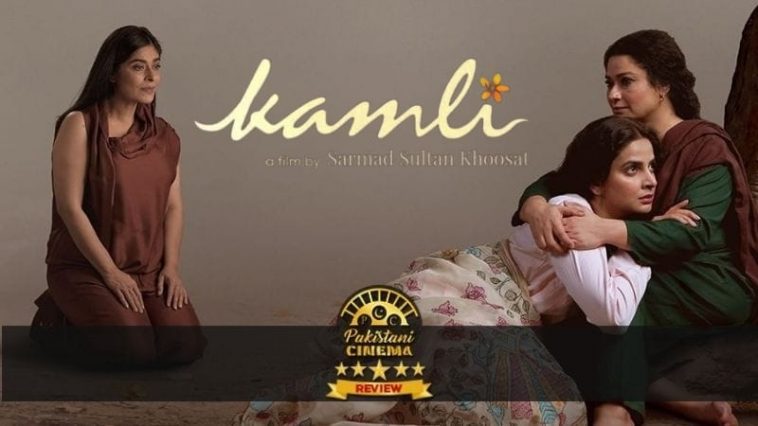From the very beginning, Sarmad Khoosat uses symbols and facial expressions to convey everything in “Kamli”. The setting is rural Punjab where religion, as well as folk stories and superstitions, form the mindset, and traditions of every household.
What was originally meant to liberate and celebrate has since become a tool of oppression. In such a place, devising one’s own “private traps”, as Alfred Hitchcock put it so eloquently in “Psycho (1960)”, is easy.
The Plot of Kamli
The plot of Kamli is straightforward enough. Saba Qamar’s character ‘Hina’ lives with her sister-in-law ‘Sakina’ played by Sania Saeed who teaches the Quran to young children. Hina works as a model for a painter played by Nimra Bucha. Hina’s husband Saqlain has been missing for 8 years without any contact. Anticipation has faded and loneliness and frustration have crept in.
Into Hina’s life walks young and handsome photographer ‘Amaltas’ played by debutant Hamza Khwaja. He wanders the plains saving bird eggs from falling out of nests, philosophizing about love, and swimming in the clear pools near Hina’s village.
Fascination turns into affection. And affection turns into passion.
But of course, that’s hardly all there is.
Writer Fatimah Sattar draws from folk traditions and local fables to construct a tightly knit screenplay which doesn’t linger. Yes, there are slower moments to help you take everything in, but they never wear out their welcome.
The Symbols of Kamli
As I mentioned in the beginning, “Kamli’s” beauty lies in its symbols and what is shown, not said. Yes, there are beautiful stories dotting the screenplay, as well as some great dialogue, but “Kamli” harkens back to the golden age of PTV more than the golden age of Pakistani Cinema.
3 times during the film I was reminded of Ashfaq Ahmad Sahab’s “Aik Mohabbat Sau Afsanay” (One Love One Hundred Stories), the original 70s Black and White anthology series on PTV. That series was also dotted with symbols and signs and madness. Unfortunately, if I give anything else away, it would be a spoiler.
The Women of Kamli
“Kamli” is a portrayal of how conventions and boundaries built by society box us all in, specifically women. And it’s the women of “Kamli” that give it such strength and verve. The title of the film could be applied to all of them.
Saba Qamar is restrained and focused and presents perhaps her best performance to date; as a result, she’s arguably never looked more beautiful in any role.
Nimra Bucha puts a lot of meat into her performance as a painter who’s lost her touch and a wife whose youth has waned.
However, it’s Sania Saeed as the devout sister-in-law Sakina who delivers the film’s best performance. Her mannerisms and delivery are effortless.
The Music of Kamli
The atmosphere of “Kamli” is made all the more intense and visceral because of its music. Composed by the talented Saad Sultan, with an extra track composed around the raw vocals of the legendary Reshma, the soundtrack of “Kamli” is something I’d listen to on a rainy afternoon. Go to Spotify or YouTube to check it out now.
The Cinematography of Kamli
It was apparent from the trailers that “Kamli” was shot by a masterful cinematographer, and it’s even more striking in the theater. Right from the opening shot, you know you’re in capable hands. Awais Gohar has filmed the landscapes in natural light, and made great use of the natural beauty around.
The film has what industry veterans would call, “Sheesha Print”. I was reminded of the Mohammad Ali and Shamim Ara starrer Humraaz from the 1960s which also featured a rural setting.
Sarmad Khoosat is One of Pakistan’s Few Dependable Directors
Sarmad Khoosat has delivered his best film. He joins the ranks of Kamal Khan (“Laal Kabootar”), Shoaib Manssoor (“Khuda Kay Liye” and “Bol”) , Nabeel Qureshi (“Na Maloom Afraad” and “Actor in Law”), Nadeem Baig (“Punjab Nahin Jaoongi” and Jawani Phir Nahin Ani”), and Bilal Lashari (“Waar” and “The Legend of Maula Jatt”) in a small, but growing list of directors who audiences can count on.
When “Kamli” ended the audience cheered and gave the film’s team a standing ovation. I just stood up and quietly left. I had too much to think about.
Please go and support “Kamli” at your nearest cinema this Friday, 3rd June. It is an original product and deserves all the success and praise it gets.



Comments
Loading…
Comments
0 comments